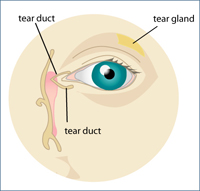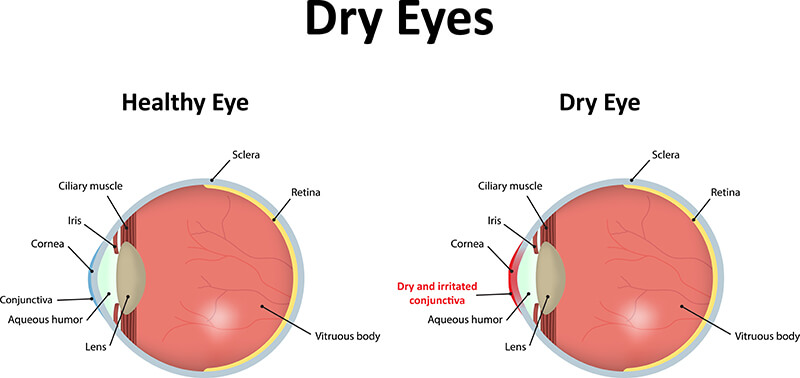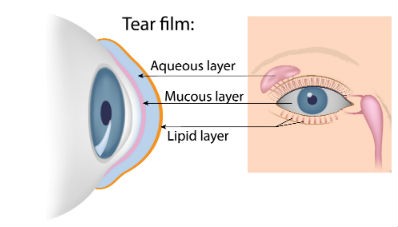Dry Eye
Dry Eye Syndrome
 Dry Eye Syndrome is a growing epidemic that has eye care professionals around the world concerned. Both optometrists and ophthalmologists are working together to evaluate and treat patients that suffer from this very distracting eye problem. Dry eye syndrome is similar to what it sounds like but constitutes a lack of lubrication or moisture in the eyes related to the tear film and production of natural tears. This syndrome can be caused by a wide variety of factors including the natural aging process, over the counter cold medicines, contact lens wear and environmental factors.
Dry Eye Syndrome is a growing epidemic that has eye care professionals around the world concerned. Both optometrists and ophthalmologists are working together to evaluate and treat patients that suffer from this very distracting eye problem. Dry eye syndrome is similar to what it sounds like but constitutes a lack of lubrication or moisture in the eyes related to the tear film and production of natural tears. This syndrome can be caused by a wide variety of factors including the natural aging process, over the counter cold medicines, contact lens wear and environmental factors.
If you suffer from a scratchy, dry or a burning sensation you may be experiencing dry eye. In order to properly diagnose this problem, you should come into our office for a visit with one of our dry eye specialists. At your visit, we will conduct a test to determine the severity of the dryness. This test is called a Schirmer test.

Diagram of Dry Eye
Understanding The Tear Film
 It is important to understand the importance of the tear film and how this relates to the dry eye disorder. The tear film is made up of three unique layers: an oily layer, a watery layer, and a mucin layer. Small glands at the perimeter of the eyelid, called meibomian glands, produce the outer, oily layer of the tear film.
It is important to understand the importance of the tear film and how this relates to the dry eye disorder. The tear film is made up of three unique layers: an oily layer, a watery layer, and a mucin layer. Small glands at the perimeter of the eyelid, called meibomian glands, produce the outer, oily layer of the tear film.
The main purpose of this oily layer is to smooth the tear surface and decrease evaporation of tears. The middle, watery layer is the largest of the three layers, and it makes up most of what we ordinarily think of as tears.
This watery layer is produced by small glands scattered through the conjunctiva, the delicate membrane lining the inside of the eyelid and covering the eyeball, and by the major tear gland, the large lacrimal gland.
The innermost layer consists of mucus produced by goblet cells in the conjunctiva. This layer allows the watery layer to spread evenly over the surface of the eye and helps the eye to remain quite moist. Without mucus, tears would not stick to the eye.
What Causes Dry Eyes?
The causes of dry eye syndrome are still being understood and researched by the medical community, but certain elements are known to cause dry eye. Various systemic diseases such as lupus, rheumatoid arthritis, or Sjögren’s Syndrome can cause dry eyes. Additionally and previously mentioned are environmental factors. Some prescription medications and over the counter medications cause dry eyes as well as contact lenses usage.
Some of the medications that cause dry eye are commonly known as Antihistamines. Antihistamines such as Benadryl, anti-depressants, and some blood pressure medications can contribute to dry eye problems. If you are a smoker and consume alcohol you have increased risk of developing dry eye syndrome

Treatment Options
Dry eye can be a difficult problem to completely cure but there has been some recent development is treating the harsh side effects of this eye condition.
Some of the recent treatment methods include:
 Restasis – a prescription medication (must consult an eye doctor prior to starting the treatment of this drug. This drug might be used as a last resort if other treatment options have been exhausted.
Restasis – a prescription medication (must consult an eye doctor prior to starting the treatment of this drug. This drug might be used as a last resort if other treatment options have been exhausted.- Nutraceuticals or dry eye vitamins – New formulations have been created that show significant help in treating dry eye. These vitamins are also excellent sources of other essential minerals. In most cases, regular or consistent usage is required to maintain results.
- Dry Eye Drops – New solutions in over the counter dry drops can be effective in the short term. Some of these drops include Allergan’s refresh tears, Soothes new eye drop and Thera Tears. Artificial tears are available without a prescription and may be used as often as necessary.
- Flaxseed oil tablets or oil – Flaxseed oil has proven to be not only good for dry eye but good for the body in general. Several studies have been undertaken that show significant evidence that taking flaxseed oil can drastically minimize the effects of dry eye syndrome. It is said that ingesting the oil is better than taking pills due to the method of which it is absorbed into your system. A suggested method of using the oil is to mix it with Italian salad dressing.
- Punctal plugs – Many eye doctors will insert small plugs that help with natural tear flow. Some plugs are even naturally dissolving.
